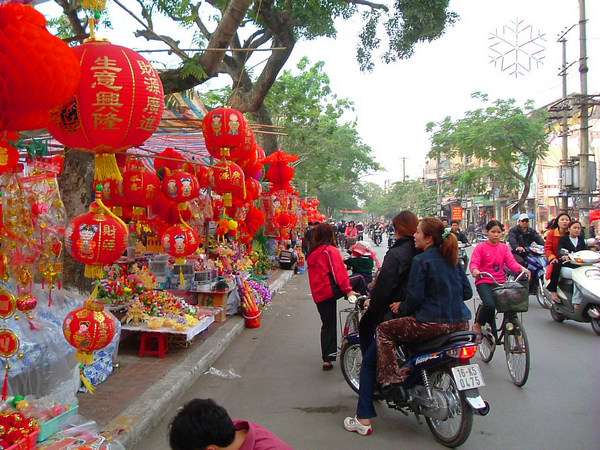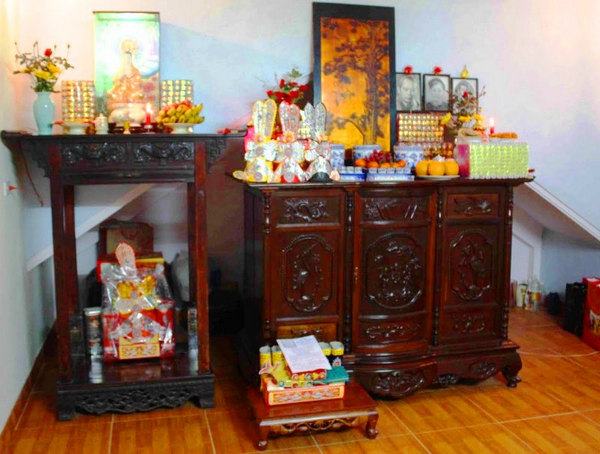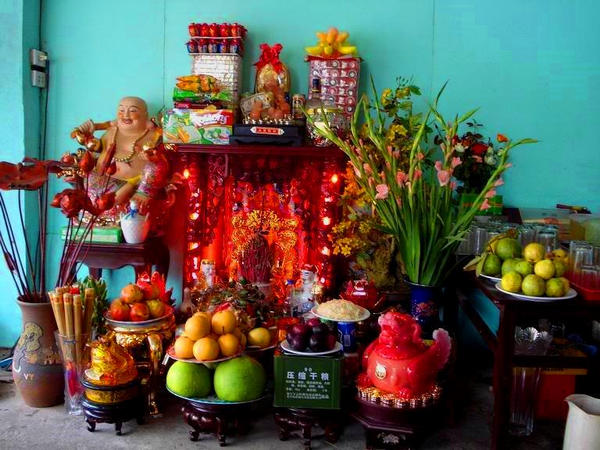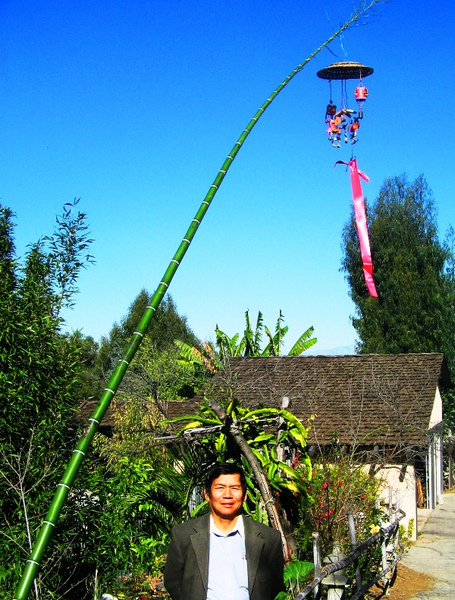The New Year in Vietnam is called Tet nguet dan, that is, “the first morning holiday,” and the abbreviated version is Tet. This is the most popular and beloved festival of the Vietnamese and it personifies all the national and cultural specifics of Vietnam. The tradition came from China and is associated with the change of seasons, with the transition from winter to spring. When the season changes, it usually begins to rain and fog in northern Vietnam.

The Vietnamese made ritual offerings to ensure that the weather was favorable and helped prepare for the sowing of grain crops. For all Vietnamese, Tet is a festival of purity and renewal. The date of the Vietnamese New Year is constantly changing depending on the lunar calendar. At the same time, China also celebrates the New Year or Spring Festival.

Long before the New Year, the Vietnamese are preparing for the holiday. The main streets of cities and towns are painted red, yellow and orange. In special markets and just on the streets, in parks and squares, fruit trees are sold: apricot and peach trees in bloom, tangerine trees with fruit and dwarf trees of bizarre shapes. Fruit trees symbolize happiness, peace, luck and prosperity. Some flower markets are colored yellow by chrysanthemums. For the people of Vietnam, this color and the flower itself symbolize immortality and prosperity.

Officially the holiday lasts three days, but people usually celebrate it for a week. Before the beginning of the festival in Vietnam, they visit relatives, pay respect to the elders of the clan, especially mothers, visit temples, make offerings, meet with friends, eat, have fun and give gifts to loved ones.
Traditions of New Year celebrations in Vietnam
1. Vietnamese clean and decorate their homes
Before New Year's Eve, houses and apartments are cleaned and cleared of old things, and then decorated. Children are responsible for cleaning. The kitchen should be cleaned on the 23rd day of the lunar month before the New Year. The head of the house cleans the altar. The Vietnamese believe that tidying up the house will rid the family of misfortunes associated with the old year. The house is then decorated with holiday symbols.
2. Get new clothes

This ritual, which takes place a month before the New Year celebrations, is the most favorite among children. Parents usually buy new clothes and shoes, but children cannot wear their new clothes until New Year's Day. Only on the first day do they put on new clothes.
3. Solemn farewell to the Kitchen God (Ong Tao)
![]()
Seven days (from the 23rd night of the last lunar month) before the Tet holiday, every Vietnamese family arranges a ceremonial farewell to Ong Tao - the Kitchen God, who is heading to the Heavenly Palace. The Vietnamese believe that Ong Tao is riding a carp to the Jade Emperor. His task is to report to the Emperor on the affairs and behavior of the family for the year. This tradition came from China, where they escort the god of the hearth - Zao Wang - to heaven for a conversation with the Heavenly Emperor Yu-di (“jade sovereign”). The Chinese appease the family spirit, because it must convey their wishes and requests. At a time when the Kitchen God is on his way to the Heavenly Palace, whole families of Vietnamese feed carp in reservoirs, so that the carp along the way will put in a good word about their good deeds and deeds.
4. New Year's Eve (Giao Thua)
Literally translated, the ritual that takes place on New Year’s Eve is called “The Transition from the Old to the New Year.” The Vietnamese believe that the 12 animals of the zodiac calendar together take control and manage earthly affairs. Thus, all twelve animals observe the transfer of power from one zodiac animal to another. New Year's Eve (Giao Thua) is the time of the return of the Kitchen God from the Jade Emperor. Each family organizes rituals for the solemn meeting.
5. First guest

Before the New Year begins in Vietnam, guests are closely monitored. The first guest who comes in first to wish the family a Happy New Year is very important for the family. If this guest is well educated, rich, respected, famous or successful, then the family will have good luck in the next year and everyone will be happy and prosperous throughout the year.
6. Apricot and peach flowers

Flower buds and flowers are symbols of any endeavor in Vietnam. But two types of flowers are especially popular here. Hoa Mai - yellow apricot flowers, common in southern Vietnam. On New Year's Day, every home in the south of the country has blooming apricot trees. Hoa Dao are pink flowered peach trees that thrive in the cool climate of northern Vietnam. Therefore, in every house in the north of the country on New Year there are peach trees or branches with peach flowers.
7. Distributing red envelopes with money
Red envelopes symbolize good luck and wealth. This ritual is performed on New Year's Day. Older people usually distribute red envelopes containing a small amount of money to young people, who in turn must listen to instructions from the older generation about studies, harmonious development of personality and relationships with each other, as well as advice to respect and obey parents.
8. Ritual offerings to ancestors

This ceremony is held on New Year's Day before noon. The head of the house must offer food, wine, cakes, fruits to his ancestors and light incense on the home altar. This is done so that the souls of ancestors join in the New Year celebrations. The well-being of the family will depend on this.
Home decoration for the New Year
Plate with five fruits
A plate filled with five types of fruit is a mandatory attribute of the Vietnamese New Year. She must stand on the ancestral altar in every Vietnamese home during all days of celebration. The fruits should be large, beautiful, preferably red, yellow or orange. The Vietnamese, like all Asians, use the five basic elements of the universe in their rituals: metal, wood, water, fire and earth. A plate of fruit on the family altar on New Year's Day shows these elements. Fruits also symbolize a good harvest and prosperity.
The following fruits can be placed on the plate: a bunch of bananas, grapefruits, palmate citrons or “Buddha’s Hands”, lemons, oranges, tangerines, apples, persimmons. The family selects only the best fruits and arranges them in a pyramid shape. Sometimes watermelons, coconuts, and dragon fruits are placed on the dish. And in some families, the offering is decorated with lanterns and flowers.
Wishes

For the New Year, every home is supposed to place wishes that are specially written by calligraphers on paper in red and black inks. These wishes on paper are posted on both sides of the front door or above the altar of the ancestors.
Christmas tree

On New Year's Day, the Vietnamese decorate their New Year tree, which they call Cay Neu. It consists of a long bamboo pole on which is a bunch of dry leaves or branches. On top of such a bamboo frame are placed fish figures and bells made of clay, which ring softly in the wind. There is also a small kerosene lamp that burns at night. Gifts are tied onto a bamboo frame. The “New Year Tree” shows the way for ancestors who return from the other world to celebrate the New Year with their family. Evil spirits are afraid to approach the pole. They are frightened by dry and prickly grass, as well as the ringing of bells. Just in case, the Vietnamese place bows and arrows in their yards, which will also ward off evil spirits.
Traditional painting
For the New Year, family members in Vietnam prepare congratulatory New Year's pictures - “chan tet” with a variety of benevolent symbols. The pictures depict instructions to the younger generation, as well as fragments from the history of Vietnam and scenes from life.
New Year's traditional dishes

One of the most traditional special dishes for Vietnamese New Year is the sticky rice cake called Banh Trang, filled with pork and green beans. Each cake is wrapped in a leaf called “duna”. The square shape of the pie has remained unchanged for many centuries. Banh Chang pies, along with other foods, fruits, and wine are placed on the altars of the ancestors. Once upon a time, making such pies was a family affair. They sat by the fireplace and prepared a New Year's dish, told fairy tales, family stories, and remembered their deceased relatives. Until now, this tradition has been preserved in the villages. But city residents buy New Year's pies in shops that line up in large numbers on the streets of small and large cities in Vietnam before the New Year.
